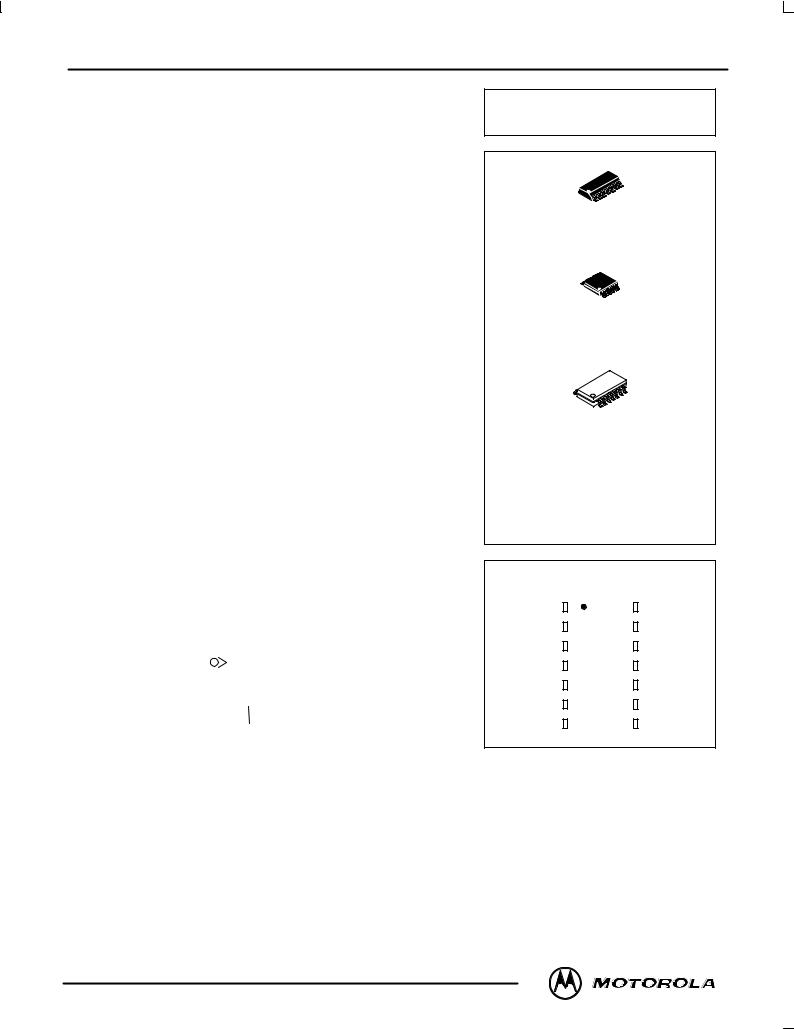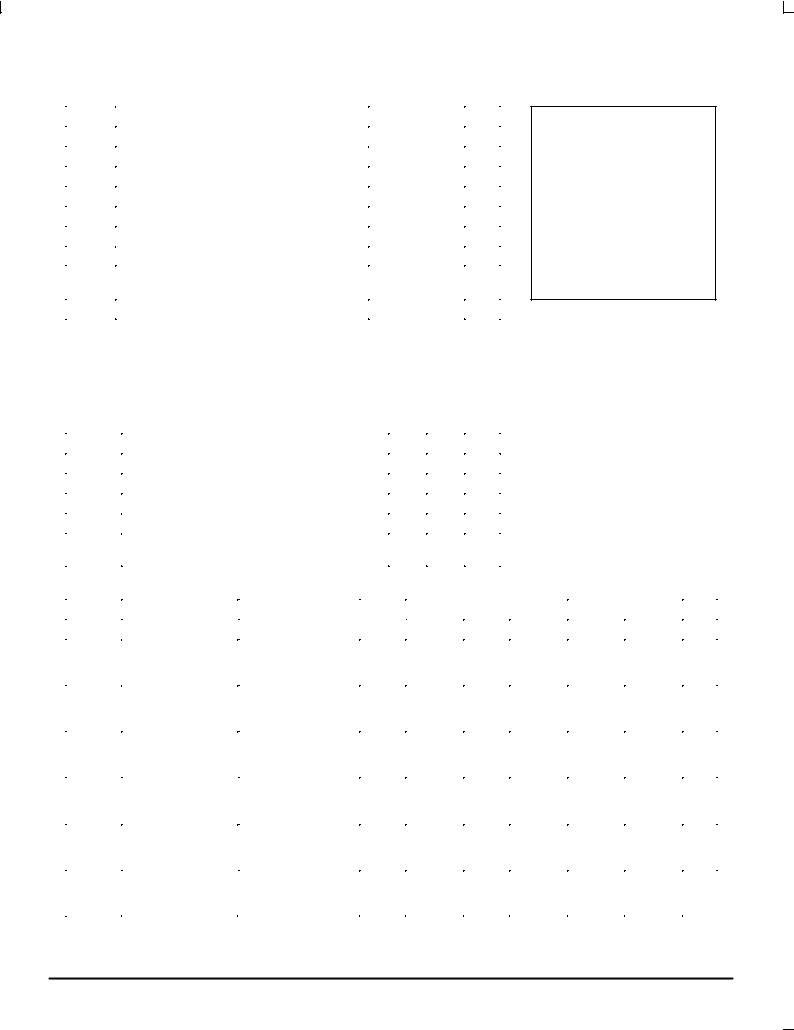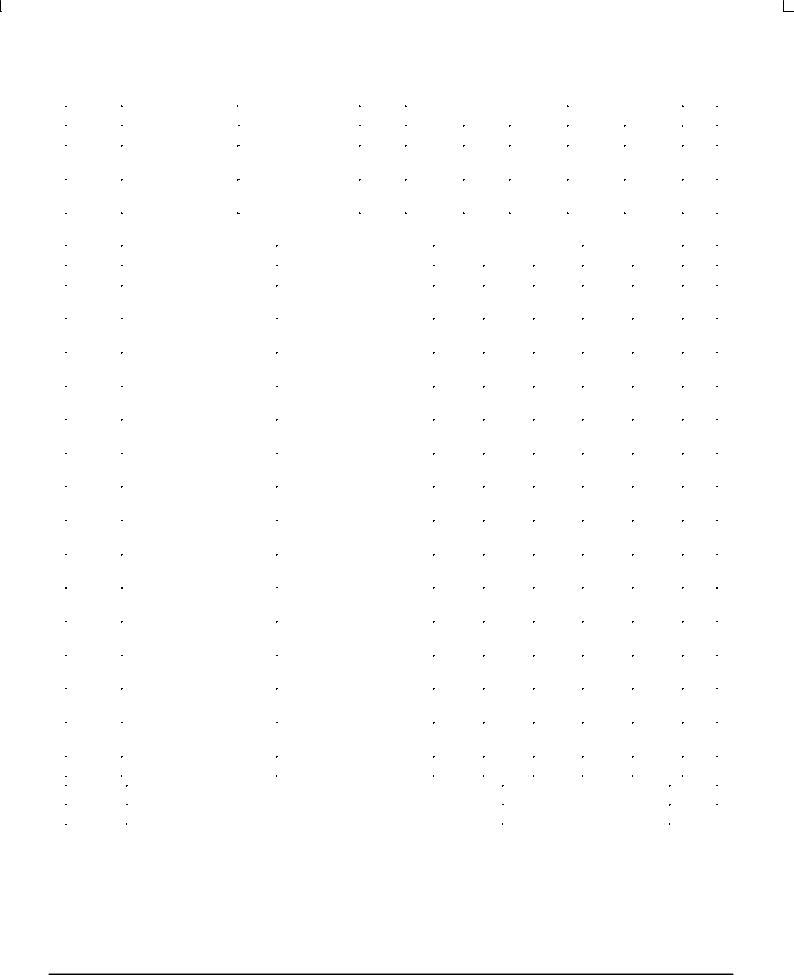MOTOROLA MC74VHC393ML1, MC74VHC393ML2, MC74VHC393M, MC74VHC393MEL, MC74VHC393D Datasheet
...
MOTOROLA
SEMICONDUCTOR TECHNICAL DATA
Dual 4-Bit Binary Ripple
Counter
The MC74VHC393 is an advanced high speed CMOS dual 4±bit binary ripple counter fabricated with silicon gate CMOS technology. It achieves high speed operation similar to equivalent Bipolar Schottky TTL while maintaining CMOS low power dissipation.
This device consists of two independent 4±bit binary ripple counters with parallel outputs from each counter stage. A 256 counter can be obtained by cascading the two binary counters.
Internal flip±flops are triggered by high±to±low transitions of the clock input. Reset for the counters is asynchronous and active±high. State changes of the Q outputs do not occur simultaneously because of internal ripple delays. Therefore, decoded output signals are subject to decoding spikes and should not be used as clocks or as strobes except when gated with the Clock of the VHC393.
The inputs tolerate voltages up to 7V, allowing the interface of 5V systems to 3V systems.
•High Speed: fmax = 170MHz (Typ) at VCC = 5V
•Low Power Dissipation: ICC = 4μA (Max) at TA = 25°C
•High Noise Immunity: VNIH = VNIL = 28% VCC
•Power Down Protection Provided on Inputs
•Balanced Propagation Delays
•Designed for 2V to 5.5V Operating Range
•Low Noise: VOLP = 0.8V (Max)
•Pin and Function Compatible with Other Standard Logic Families
•Latchup Performance Exceeds 300mA
•ESD Performance: HBM > 2000V; Machine Model > 200V
•Chip Complexity: 236 FETs or 59 Equivalent Gates
LOGIC DIAGRAM
|
|
|
|
|
BINARY |
3, 11 |
nQA |
|
|
|
|
|
|
4, 10 |
|||
|
|
1, 13 |
|
COUNTER |
nQB |
|||
CPn |
|
|
|
5, 9 |
||||
|
|
|
|
|||||
|
|
|
|
|
nQC |
|||
|
|
|
|
|
|
|
6, 8 |
|
|
|
|
|
|
|
|
nQD |
|
RDn |
2, 12 |
|
|
|
|
|||
|
|
|
|
|
||||
|
|
|
|
|
||||
|
|
|
|
|
|
|
||
FUNCTION TABLE
Inputs |
|
|
Clock |
Reset |
Outputs |
|
|
|
X |
H |
L |
H |
L |
No Change |
L |
L |
No Change |
↑ |
L |
No Change |
↓ |
L |
Next State |
|
|
|
MC74VHC393
D SUFFIX
14±LEAD SOIC PACKAGE
CASE 751A±03
DT SUFFIX
14±LEAD TSSOP PACKAGE
CASE 948G±01
M SUFFIX
14±LEAD SOIC EIAJ PACKAGE
CASE 965±01
ORDERING INFORMATION
MC74VHCXXXD SOIC MC74VHCXXXDT TSSOP MC74VHCXXXM SOIC EIAJ
PIN ASSIGNMENT
|
|
|
|
|
|
|
|
|
CP1 |
1 |
14 |
|
VCC |
||
RD1 |
2 |
13 |
|
CP2 |
|
||
1QA |
3 |
12 |
|
RD2 |
|||
1QB |
4 |
11 |
|
2QA |
|||
1QC |
5 |
10 |
|
2QB |
|||
1QD |
6 |
9 |
|
2QC |
|||
GND |
7 |
8 |
|
2QD |
|||
|
|
|
|
|
|
|
|
6/97
Motorola, Inc. 1997 |
1 |
REV 0 |

MC74VHC393
MAXIMUM RATINGS*
Symbol |
Parameter |
|
Value |
Unit |
|
|
|
|
|
VCC |
DC Supply Voltage |
|
± 0.5 to + 7.0 |
V |
Vin |
DC Input Voltage |
|
± 0.5 to + 7.0 |
V |
Vout |
DC Output Voltage |
|
± 0.5 to VCC + 0.5 |
V |
IIK |
Input Diode Current |
|
± 20 |
mA |
IOK |
Output Diode Current |
|
± 20 |
mA |
Iout |
DC Output Current, per Pin |
|
± 25 |
mA |
ICC |
DC Supply Current, VCC and GND Pins |
± 75 |
mA |
|
PD |
Power Dissipation in Still Air, |
SOIC Packages² |
500 |
mW |
|
|
TSSOP Package² |
450 |
|
|
|
|
|
|
Tstg |
Storage Temperature |
|
± 65 to + 150 |
_C |
*Absolute maximum continuous ratings are those values beyond which damage to the device may occur. Exposure to these conditions or conditions beyond those indicated may adversely affect device reliability. Functional operation under absolute±maximum±rated conditions is not implied.
²Derating Ð SOIC Packages: ± 7 mW/ _C from 65_ to 125_C TSSOP Package: ± 6.1 mW/_C from 65_ to 125_C
RECOMMENDED OPERATING CONDITIONS
Symbol |
Parameter |
|
Min |
Max |
Unit |
|
|
|
|
|
|
VCC |
DC Supply Voltage |
|
2.0 |
5.5 |
V |
Vin |
DC Input Voltage |
|
0 |
5.5 |
V |
Vout |
DC Output Voltage |
|
0 |
VCC |
V |
TA |
Operating Temperature |
|
± 40 |
+ 85 |
_C |
tr, tf |
Input Rise and Fall Time |
VCC = 3.3V |
0 |
100 |
ns/V |
|
|
VCC = 5.0V |
0 |
20 |
|
DC ELECTRICAL CHARACTERISTICS
This device contains protection circuitry to guard against damage due to high static voltages or electric fields. However, precautions must be taken to avoid applications of any voltage higher than maximum rated voltages to this high±impedance circuit. For proper operation, Vin and Vout should be constrained to the
range GND v (Vin or Vout) v VCC. Unused inputs must always be
tied to an appropriate logic voltage level (e.g., either GND or VCC). Unused outputs must be left open.
|
|
|
VCC |
|
TA = 25°C |
|
TA = ± 40 to 85°C |
|
|
Symbol |
Parameter |
Test Conditions |
V |
Min |
Typ |
Max |
Min |
Max |
Unit |
|
|
|
|
|
|
|
|
|
|
VIH |
Minimum High±Level |
|
2.0 |
1.50 |
|
|
1.50 |
|
V |
|
Input Voltage |
|
3.0 to |
VCC x 0.7 |
|
|
VCC x 0.7 |
|
|
|
|
|
5.5 |
|
|
|
|
|
|
|
|
|
|
|
|
|
|
|
|
VIL |
Maximum Low±Level |
|
2.0 |
|
|
0.50 |
|
0.50 |
V |
|
Input Voltage |
|
3.0 to |
|
|
VCC x 0.3 |
|
VCC x 0.3 |
|
|
|
|
5.5 |
|
|
|
|
|
|
|
|
|
|
|
|
|
|
|
|
VOH |
Minimum High±Level |
Vin = VIH or VIL |
2.0 |
1.9 |
2.0 |
|
1.9 |
|
V |
|
Output Voltage |
IOH = ± 50μA |
3.0 |
2.9 |
3.0 |
|
2.9 |
|
|
|
|
|
4.5 |
4.4 |
4.5 |
|
4.4 |
|
|
|
|
|
|
|
|
|
|
|
|
|
|
Vin = VIH or VIL |
|
|
|
|
|
|
|
|
|
IOH = ± 4mA |
3.0 |
2.58 |
|
|
2.48 |
|
|
|
|
IOH = ± 8mA |
4.5 |
3.94 |
|
|
3.80 |
|
|
VOL |
Maximum Low±Level |
Vin = VIH or VIL |
2.0 |
|
0.0 |
0.1 |
|
0.1 |
V |
|
Output Voltage |
IOL = 50μA |
3.0 |
|
0.0 |
0.1 |
|
0.1 |
|
|
|
|
4.5 |
|
0.0 |
0.1 |
|
0.1 |
|
|
|
|
|
|
|
|
|
|
|
|
|
Vin = VIH or VIL |
|
|
|
|
|
|
|
|
|
IOL = 4mA |
3.0 |
|
|
0.36 |
|
0.44 |
|
|
|
IOL = 8mA |
4.5 |
|
|
0.36 |
|
0.44 |
|
MOTOROLA |
2 |
VHC Data ± Advanced CMOS Logic |
|
|
DL203 Ð Rev 1 |

MC74VHC393
DC ELECTRICAL CHARACTERISTICS
|
|
|
VCC |
|
TA = 25°C |
|
TA = ± 40 to 85°C |
|
|
Symbol |
Parameter |
Test Conditions |
V |
Min |
Typ |
Max |
Min |
Max |
Unit |
|
|
|
|
|
|
|
|
|
|
Iin |
Maximum Input |
Vin = 5.5V or GND |
0 to 5.5 |
|
|
± 0.1 |
|
± 1.0 |
μA |
|
Leakage Current |
|
|
|
|
|
|
|
|
|
|
|
|
|
|
|
|
|
|
ICC |
Maximum Quiescent |
Vin = VCC or GND |
5.5 |
|
|
4.0 |
|
40.0 |
μA |
|
Supply Current |
|
|
|
|
|
|
|
|
|
|
|
|
|
|
|
|
|
|
AC ELECTRICAL CHARACTERISTICS (Input tr = tf = 3.0ns)
|
|
|
|
|
|
TA = 25°C |
|
|
TA = ± 40 to 85°C |
|
|||
Symbol |
|
Parameter |
Test Conditions |
Min |
Typ |
Max |
|
Min |
Max |
Unit |
|||
|
|
|
|
|
|
|
|
|
|
|
|
|
|
fmax |
|
Maximum Clock Frequency |
VCC = 3.3 ± 0.3V |
CL = 15pF |
75 |
120 |
|
|
65 |
|
|
ns |
|
|
|
(50% Duty Cycle) |
|
CL = 50pF |
45 |
65 |
|
|
35 |
|
|
|
|
|
|
|
VCC = 5.0 ± 0.5V |
CL = 15pF |
125 |
170 |
|
|
105 |
|
|
|
|
|
|
|
|
CL = 50pF |
85 |
115 |
|
|
75 |
|
|
|
|
tPLH, |
|
Maximum Propagation Delay, |
VCC = 3.3 ± 0.3V |
CL = 15pF |
|
8.6 |
13.2 |
|
1.0 |
15.5 |
|
ns |
|
tPHL |
|
CP to QA |
|
CL = 50pF |
|
11.1 |
16.7 |
|
1.0 |
19.0 |
|
|
|
|
|
|
VCC = 5.0 ± 0.5V |
CL = 15pF |
|
5.8 |
8.5 |
|
1.0 |
10.0 |
|
|
|
|
|
|
|
CL = 50pF |
|
7.3 |
10.5 |
|
1.0 |
12.0 |
|
|
|
tPLH, |
|
Maximum Propagation Delay, |
VCC = 3.3 ± 0.3V |
CL = 15pF |
|
10.2 |
15.8 |
|
1.0 |
18.5 |
|
ns |
|
tPHL |
|
CP to QB |
|
CL = 50pF |
|
12.7 |
19.3 |
|
1.0 |
22.0 |
|
|
|
|
|
|
VCC = 5.0 ± 0.5V |
CL = 15pF |
|
6.8 |
9.8 |
|
1.0 |
11.5 |
|
|
|
|
|
|
|
CL = 50pF |
|
8.3 |
11.8 |
|
1.0 |
13.5 |
|
|
|
tPLH, |
|
Maximum Propagation Delay, |
VCC = 3.3 ± 0.3V |
CL = 15pF |
|
11.7 |
18.0 |
|
1.0 |
21.0 |
|
ns |
|
tPHL |
|
CP to QC |
|
CL = 50pF |
|
14.2 |
21.5 |
|
1.0 |
24.5 |
|
|
|
|
|
|
VCC = 5.0 ± 0.5V |
CL = 15pF |
|
7.7 |
11.2 |
|
1.0 |
13.0 |
|
|
|
|
|
|
|
CL = 50pF |
|
9.2 |
13.2 |
|
1.0 |
15.0 |
|
|
|
tPLH, |
|
Maximum Propagation Delay, |
VCC = 3.3 ± 0.3V |
CL = 15pF |
|
13.0 |
19.7 |
|
1.0 |
23.0 |
|
ns |
|
tPHL |
|
CP to QD |
|
CL = 50pF |
|
15.5 |
23.2 |
|
1.0 |
26.5 |
|
|
|
|
|
|
VCC = 5.0 ± 0.5V |
CL = 15pF |
|
8.5 |
12.5 |
|
1.0 |
14.5 |
|
|
|
|
|
|
|
CL = 50pF |
|
10.0 |
14.5 |
|
1.0 |
16.5 |
|
|
|
tPHL |
|
Maximum Propagation Delay, |
VCC = 3.3 ± 0.3V |
CL = 15pF |
|
7.9 |
12.3 |
|
1.0 |
14.5 |
|
ns |
|
|
|
RD to Qn |
|
CL = 50pF |
|
10.4 |
15.8 |
|
1.0 |
18.0 |
|
|
|
|
|
|
VCC = 5.0 ± 0.5V |
CL = 15pF |
|
5.4 |
8.1 |
|
1.0 |
9.5 |
|
|
|
|
|
|
|
CL = 50pF |
|
6.9 |
10.1 |
|
1.0 |
11.5 |
|
|
|
tOSLH, |
|
Output to Output Skew |
VCC = 3.3 ± 0.3V |
CL = 50pF |
|
|
|
1.5 |
|
|
1.5 |
|
pF |
tOSHL |
|
|
(Note NO TAG) |
|
|
|
|
|
|
|
|
|
|
|
|
|
VCC = 5.0 ± 0.5V |
CL = 50pF |
|
|
|
1.0 |
|
|
1.0 |
|
pF |
|
|
|
(Note NO TAG) |
|
|
|
|
|
|
|
|
|
|
|
|
|
|
|
|
|
|
|
|
|
|
|
|
Cin |
|
Maximum Input Capacitance |
|
|
|
4 |
10 |
|
|
10 |
|
pF |
|
|
|
|
|
|
|
|
|
|
|
||||
|
|
|
|
|
|
|
Typical @ 25°C, VCC = 5.0V |
|
|
||||
CPD |
|
Power Dissipation Capacitance (Note NO TAG) |
|
|
|
|
|
23 |
|
|
pF |
||
1.Parameter guaranteed by design. tOSLH = |tPLHm ± tPLHn|, tOSHL = |tPHLm ± tPHLn|.
2.CPD is defined as the value of the internal equivalent capacitance which is calculated from the operating current consumption without load.
Average operating current can be obtained by the equation: ICC(OPR) = CPD VCC fin + ICC / 2 (per 4±bit counter). CPD is used to determine the no±load dynamic power consumption; PD = CPD VCC2 fin + ICC VCC.
VHC Data ± Advanced CMOS Logic |
3 |
MOTOROLA |
DL203 Ð Rev 1 |
|
|
